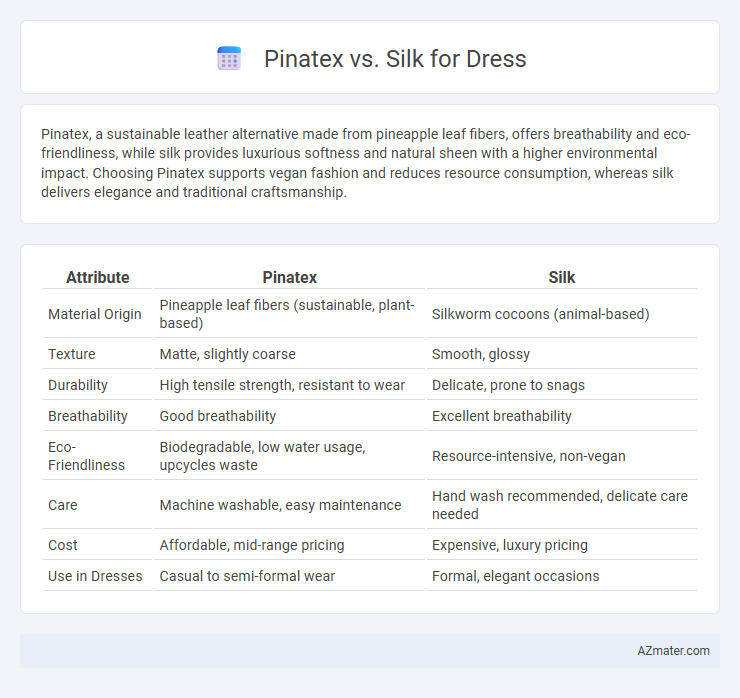Pinatex, a sustainable leather alternative made from pineapple leaf fibers, offers breathability and eco-friendliness, while silk provides luxurious softness and natural sheen with a higher environmental impact. Choosing Pinatex supports vegan fashion and reduces resource consumption, whereas silk delivers elegance and traditional craftsmanship.
Table of Comparison
| Attribute | Pinatex | Silk |
|---|---|---|
| Material Origin | Pineapple leaf fibers (sustainable, plant-based) | Silkworm cocoons (animal-based) |
| Texture | Matte, slightly coarse | Smooth, glossy |
| Durability | High tensile strength, resistant to wear | Delicate, prone to snags |
| Breathability | Good breathability | Excellent breathability |
| Eco-Friendliness | Biodegradable, low water usage, upcycles waste | Resource-intensive, non-vegan |
| Care | Machine washable, easy maintenance | Hand wash recommended, delicate care needed |
| Cost | Affordable, mid-range pricing | Expensive, luxury pricing |
| Use in Dresses | Casual to semi-formal wear | Formal, elegant occasions |
Introduction: Piñatex and Silk Explained
Pinatex is an innovative, sustainable fabric derived from pineapple leaf fibers that offers a cruelty-free and eco-friendly alternative to traditional textiles, while silk is a natural protein fiber produced by silkworms known for its luxurious texture and sheen. Pinatex provides durability and breathability suitable for everyday wear, whereas silk is prized for its softness and elegance but requires more delicate care. Both materials offer distinct qualities, making them popular choices for different types of dresses based on sustainability, appearance, and comfort.
Material Origins and Production Processes
Pinatex is derived from pineapple leaf fibers, making it a sustainable byproduct of the agricultural industry, while silk originates from silkworm cocoons through traditional sericulture. Pinatex production avoids harmful chemicals and utilizes renewable materials, promoting eco-friendly practices, whereas silk requires intensive labor and the use of natural protein fibers, often involving significant water and energy consumption. Both materials offer unique textures and qualities, but Pinatex stands out for its plant-based origin and lower environmental impact compared to the silk's animal-derived production.
Environmental Impact: Sustainability Comparison
Pinatex is made from pineapple leaf fibers, a byproduct of pineapple harvesting, promoting zero waste and reducing reliance on synthetic materials, making it highly sustainable. Silk production involves silkworm farming, which requires significant water, energy, and land resources, and often results in the death of silkworms, raising ethical and environmental concerns. Pinatex offers a lower carbon footprint and less resource-intensive alternative, positioning it as a more eco-friendly choice for sustainable dress materials.
Texture, Feel, and Comfort in Wearing
Pinatex offers a unique texture with a slightly coarse, fibrous surface resembling natural leather, providing breathability and durability ideal for structured dresses. Silk boasts a smooth, glossy texture that feels luxuriously soft against the skin, delivering exceptional comfort and lightweight wear perfect for flowing, elegant dresses. Pinatex is more breathable and eco-friendly but less silky, whereas silk excels in softness and drape, offering superior comfort for sensitive skin.
Visual Appeal and Color Versatility
Pinatex offers a unique textured surface with a natural, matte finish that provides a tropical, organic look ideal for casual or eco-conscious fashion. Silk boasts a smooth, lustrous sheen and rich color depth, delivering timeless elegance and a wide spectrum of vibrant hues suitable for formal dresses. While Pinatex excels in earth tones and subtle variations, silk outperforms in color versatility, supporting bright, pastel, and deep shades with consistent vibrancy.
Durability and Maintenance Needs
Pinatex, made from pineapple leaf fibers, offers strong durability with natural resistance to wear and tear, making it ideal for sustainable dresses that require minimal maintenance. Silk, valued for its smooth texture and elegance, demands careful handling and regular delicate cleaning to maintain its integrity and vibrant appearance. Choosing between Pinatex and silk depends on prioritizing eco-friendly durability versus luxurious feel and maintenance commitment.
Price Comparison: Piñatex vs. Silk
Pinatex dress fabric generally ranges from $30 to $60 per yard, positioning it as an affordable, sustainable alternative to luxury silk, which typically costs between $50 and $200 per yard. The lower price of Pinatex reflects its use of pineapple leaf fibers, reducing material costs compared to the labor-intensive extraction of silk from silkworms. Consumers seeking eco-friendly options often find Pinatex offers a cost-effective and durable substitute without compromising style.
Ethical Considerations: Animal Welfare and Labor
Pinatex, derived from pineapple leaf fibers, offers a sustainable alternative that avoids animal exploitation, promoting superior animal welfare compared to traditional silk production, which involves silkworm harvesting. Labor conditions in Pinatex supply chains often support rural agricultural communities with fair trade practices, while silk manufacturing can involve labor-intensive processes with varying standards of worker rights, sometimes linked to less regulated environments. Ethical considerations favor Pinatex for its cruelty-free origins and potential for transparent, equitable labor practices in the fashion industry.
Fashion Industry Adoption and Trends
Pinatex, a sustainable alternative made from pineapple leaf fibers, is gaining rapid adoption in the fashion industry as brands seek eco-friendly materials that reduce environmental impact. Silk, a traditional luxury fabric valued for its smooth texture and natural sheen, faces challenges due to ethical concerns and resource-intensive production, prompting designers to explore vegan alternatives like Pinatex. Trends highlight increasing consumer demand for cruelty-free and sustainable fabrics, driving innovation and broader acceptance of plant-based materials in contemporary dressmaking.
Conclusion: Choosing the Best Fabric for Dresses
Pinatex offers a sustainable and cruelty-free alternative with a unique texture derived from pineapple leaf fibers, ideal for eco-conscious fashion designers. Silk provides luxurious softness and natural sheen, favored for formal and elegant dresses demanding fluidity and comfort. Selecting the best fabric depends on priorities such as sustainability, texture, durability, and occasion-specific style requirements.

Infographic: Piñatex vs Silk for Dress
 azmater.com
azmater.com